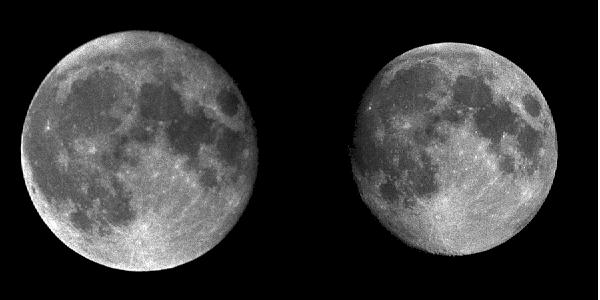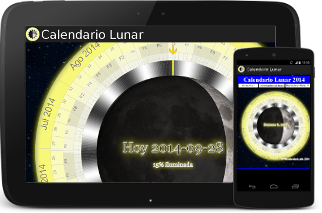The Moon
The Moon is the only natural satellite of the Earth thought to have been formed from debris of about 4.5 billion years ago, shortly after the formation of the Earth. The Moon is in synchronous rotation with Earth, always showing the same face. The gravitational influence of the moon causes tides of the ocean and the slight lengthening of the day.
The phase and libration of the Moon for 2014, at hourly intervals. Includes supplemental graphics that display the Moon's orbit, subsolar and sub-Earth points, and the Moon's distance from Earth at true scale.
- Northern Hemisphere
- Southern Hemisphere
Moon - Northern Hemisphere
Crédito: NASA's Goddard Space Flight Center Scientific Visualization Studio
From any place on Earth, the Moon seems to be circular disc illuminated somewhat by sunlight. Like Earth, the Moon is a sphere that has face always sunlit. As the moon orbits the Earth we see more or less of the illuminated half. During each lunar orbit (lunar month), we see the appearance of the Moon change from not illuminated to partially and fully illuminated, and then backwards from fully illuminated to partially and not illuminated. There are eight different traditionally recognized stages in this Moon illumination cycle, called Moon phases. The phases designate both the degree to which the Moon is illuminated and the geometric aspect of the illuminated part. These phases of the Moon, in sequence of their appearance (from New Moon), are listed below.
Moon Phases
| Northern Hemisphere | Southern Hemisphere | |
|---|---|---|
 |
 |
New Moon - Unlit side of the Moon facing the Earth. During this phase, the Moon is not visible (except during a solar eclipse). |
 |
 |
Waxing Moon - The moon appears to begin to be enlightened by direct sunlight. The fraction of the illuminated disk of the Moon increases. |
 |
 |
1st Quarter Moon - Half the Moon appears to be illuminated by direct sunlight. The fraction of the illuminated disk of the Moon increases. |
 |
 |
Waxing Gibbous Moon - More than half of the Moon is illuminated, but not completely. The fraction of the illuminated disk of the Moon increases. |
 |
 |
Full Moon - The sunlit side of the Moon facing Earth. The Moon is shown completely illuminated by direct sunlight. |
 |
 |
Waning Gibbous Moon - More than half of the Moon is illuminated, but not completely. The fraction of the illuminated disk of the Moon decreases. |
 |
 |
Last Quarter Moon - Half the Moon appears to be illuminated by direct sunlight. The fraction of the illuminated disk of the moon decreases. |
 |
 |
Waning Moon - Less than half of the Moon is illuminated. The fraction of the illuminated disk of the Moon decreases. |
After the waning moon phase New Moon follows. Note that the Moon waxes and wanes in the Northern Hemisphere from right to left, whereas the Moon waxes and wanes from left to right in the southern hemisphere.
The average duration of the lunar cycle, from the beginning of the New Moon until the completion of the waning moon, is 29.5 days. The number of days past the New Moon phase is what people refer to as the "Moon age". Because the lunar cycle usually lasts less than a month in the Gregorian calendar, any of the moon phases may occur twice, at the beginning and end of the month. When two full moons occur in the same month, the second full moon is called a Blue Moon. Blue Moon occurs on average every 2.7 years.
Although the Full Moon occurs every month on a specific date and time, the Moon may seem full for several nights in a row if the sky is clear. This is because the illumination of the Moon changes very slowly around the Full Moon phase (also around the New Moon, but the Moon is not visible at this stage).
The phases of the Moon are associated with (actually caused by) the relative positions of the Moon and Sun in the sky. For example, the New Moon occurs when the Sun and Moon are quite close together in the sky. The Full Moon occurs when the Sun and Moon are in nearly opposite positions in the sky - for most places on Earth, a full moon rises at sunset and sets at sunrise. The First Quarter Moon and the Last Quarter Moon occurs when the Sun and Moon are about 90 degrees apart in the sky.
The phases of the moon and the percentage of the Moon illuminated are the same regarless of the position of the observer on the surface of the Earth.
Perigee and Apogee of the Moon
The orbit of the Moon is clearly elliptical, with an average eccentricity of 0.0549. Therefore, the distance between the Moon and the Earth varies as the Moon moves through its orbit. The point at which the Moon is closest to Earth is called perigee, and when farthest it is called apogee. The Moon at perigee is 11% closer to the Earth than the Moon at apogee.
The following is a comparison of photographs taken of the moon during perigee and apogee. The size and brightness difference is striking. However, usually the human eye does not notice the difference when the Moon is in the sky because we have nothing to compare it with at that time.


